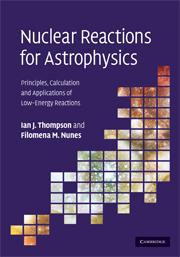Book contents
- Frontmatter
- Contents
- Preface
- Sources of quotations
- Acknowledgements
- 1 Nuclei in the Cosmos
- 2 Reactions of nuclei
- 3 Scattering theory
- 4 Reaction mechanisms
- 5 Connecting structure with reactions
- 6 Solving the equations
- 7 Approximate solutions
- 8 Breakup
- 9 Three-body nuclei
- 10 R-matrix phenomenology
- 11 Compound-nucleus averaging
- 12 Stellar reaction rates and networks
- 13 Connection to experiments
- 14 Spectroscopy
- 15 Fitting data
- Appendix A Symbols
- Appendix B Getting started with Fresco
- Select bibliography
- Index
11 - Compound-nucleus averaging
Published online by Cambridge University Press: 05 March 2012
- Frontmatter
- Contents
- Preface
- Sources of quotations
- Acknowledgements
- 1 Nuclei in the Cosmos
- 2 Reactions of nuclei
- 3 Scattering theory
- 4 Reaction mechanisms
- 5 Connecting structure with reactions
- 6 Solving the equations
- 7 Approximate solutions
- 8 Breakup
- 9 Three-body nuclei
- 10 R-matrix phenomenology
- 11 Compound-nucleus averaging
- 12 Stellar reaction rates and networks
- 13 Connection to experiments
- 14 Spectroscopy
- 15 Fitting data
- Appendix A Symbols
- Appendix B Getting started with Fresco
- Select bibliography
- Index
Summary
Science makes people reach selflessly for truth and objectivity; it teaches people to accept reality, with wonder and admiration, not to mention the deep joy and awe that the natural order of things brings to the true scientist.
Lise MeitnerCompound-nucleus phenomena
In Chapter 2 we saw how nuclear reactions are broadly dominated by two kinds of timescales: the fast direct reactions and the slower compound-nucleus (CN) reactions. The direct reactions are typically described in R-matrix theory by a few poles with large widths, whereas there are usually very many compound-nucleus resonances, each of which has a narrow width.
Direct reactions are generally foward-peaked with respect to the incident direction, whereas the CN process has less ‘memory’ about that direction and gives products which are typically symmetric about 90°. Usually it is possible to experimentally separate the symmetric contributions to a given outgoing channel, and theoretically the direct and CN cross sections are calculated by quite different methods.We will sometimes try to model the detailed resonance structure of theCN process, but usually calculate the reaction rates averaging over manyCNlevels, and use only statistical features of these levels, such as their average spacings and widths.
- Type
- Chapter
- Information
- Nuclear Reactions for AstrophysicsPrinciples, Calculation and Applications of Low-Energy Reactions, pp. 314 - 339Publisher: Cambridge University PressPrint publication year: 2009

